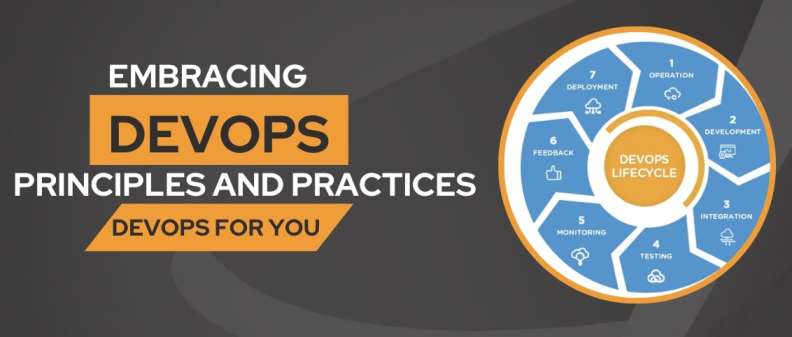
Introduction
Have you ever wondered how some companies manage to release software updates so quickly and efficiently? The answer lies in a revolutionary approach to software development and IT operations, known as DevOps. In this article, we’ll take a deep dive into the world of DevOps, its evolution, key principles, tools, benefits, and much more. So buckle up and let’s explore this amazing approach together!
What is DevOps?
DevOps is a combination of two words – Development (Dev) and Operations (Ops). It’s an approach that bridges the gap between software development and IT operations, enabling teams to deliver high-quality software quickly and efficiently. DevOps emphasizes collaboration, automation, and continuous improvement, creating a culture where both developers and operations work together to achieve a common goal.
The Evolution of DevOps
To understand DevOps better, let’s take a brief look at its evolution.
From Waterfall to Agile
Before DevOps, software development followed the Waterfall model, where each stage of the process was sequential, and changes were difficult to make once a stage was completed. This led to slow releases and low-quality products. Then came the Agile methodology, which allowed for flexibility and iterative improvements. However, Agile didn’t address the collaboration and communication issues between development and operations teams.
The Birth of DevOps
DevOps emerged as a solution to the challenges faced by development and operations teams. It was first coined in 2009 by Patrick Debois and Andrew Clay Shafer. DevOps aims to bring the best of both worlds – Agile’s flexibility and iterative approach, combined with a focus on collaboration and automation between development and operations.
The Importance of DevOps
DevOps has become increasingly important in today’s fast-paced, competitive market. It enables organizations to release high-quality software quickly and efficiently, ensuring customer satisfaction and business growth. DevOps also fosters a culture of continuous improvement, allowing companies to adapt and innovate rapidly.
Key DevOps Principles
There are three main principles that drive DevOps:
Continuous Integration
Continuous Integration (CI) is the practice of integrating code changes frequently, typically multiple times a day. This helps catch issues early, reducing the time and effort required to fix them.
Continuous Deployment
Continuous Deployment (CD) is the practice of automatically deploying code changes to production without human intervention. This ensures faster delivery of new features and bug fixes.
Continuous Delivery
Continuous Delivery is the process of ensuring that the software is always in a releasable state. It involves automated testing and validation to ensure high-quality software with minimal risk of deployment failures.
DevOps Tools and Technologies
To implement DevOps effectively, various tools and technologies are used at different stages of the software development lifecycle. Some of these include:
Version Control Systems
Version control systems like Git, Mercurial, and Subversion help track and manage code changes, enabling collaboration and seamless integration of new code.
Build Automation Tools
Build automation tools like Maven, Gradle, and Ant to automate the process of compiling, packaging, and creating artifacts, reducing human error and speeding up the development process.
Configuration Management Tools
Configuration management tools like Ansible, Puppet, and Chef ensure consistent configurations across environments, reducing deployment failures and enhancing security.
Continuous Integration and Deployment Tools
CI/CD tools like Jenkins, Bamboo, and CircleCI help automate the process of integrating, testing, and deploying code changes, ensuring faster and more reliable releases.
Monitoring and Logging Tools
Monitoring and logging tools like Prometheus, ELK Stack, and Grafana help identify and resolve issues quickly, ensuring the performance and stability of the software.
DevOps and Cloud Computing
Cloud computing has played a significant role in the widespread adoption of DevOps. With the ability to quickly provision and scale resources, cloud platforms like AWS, Azure, and Google Cloud Platform have made it easier for organizations to implement DevOps practices. Cloud-based tools and services further enhance collaboration, automation, and monitoring capabilities.
DevOps Culture
A successful DevOps implementation goes beyond tools and technologies. It requires a shift in organizational culture, encompassing the following aspects:
Collaboration
Breaking down silos and fostering collaboration between development and operations teams is crucial for the success of DevOps. Open communication and shared responsibilities enable teams to work together efficiently.
Automation
By automating repetitive tasks, teams can focus on more important aspects of software development, such as designing better features and addressing customer needs.
Measurement
Measuring and monitoring key performance indicators (KPIs) help identify areas of improvement and ensure the continuous enhancement of processes and practices.
Sharing
Sharing knowledge, experiences, and best practices across teams helps create a culture of continuous learning and improvement.
Benefits of DevOps
Organizations that embrace DevOps can reap numerous benefits, including:
- Faster software releases and updates
- Improved collaboration and communication
- Enhanced software quality and reliability
- Reduced deployment failures and downtime
- Greater adaptability to market changes
- Increased customer satisfaction
Challenges in Implementing DevOps
Despite its many benefits, implementing DevOps can be challenging, as it requires changes in organizational culture, processes, and tools. Some common challenges include:
- Resistance to change
- Lack of skilled professionals
- Inadequate tools and infrastructure
- Balancing security and speed
- Measuring and demonstrating ROI
DevOps Best Practices
To overcome these challenges and ensure a successful DevOps implementation, consider the following best practices:
- Start small and scale gradually
- Build a cross-functional team
- Establish a blame-free culture
- Automate processes wherever possible
- Continuously monitor, measure, and improve
Future of DevOps
The future of DevOps looks promising, with advancements in artificial intelligence, machine learning, and cloud computing expected to further enhance automation, monitoring, and collaboration capabilities. As organizations continue to recognize the value of DevOps, its adoption is likely to grow, paving the way for even more efficient and innovative software development practices.
Conclusion
DevOps has revolutionized software development and IT operations, enabling organizations to deliver high-quality software quickly and efficiently. By fostering a culture of collaboration, automation, and continuous improvement, DevOps has become an essential approach for companies looking to stay competitive in today’s fast-paced market. With the right tools, technologies, and organizational mindset, DevOps can drive significant benefits, including faster releases, improved software quality, and increased customer satisfaction. As the future unfolds, DevOps will continue to evolve, leveraging emerging technologies and best practices to further enhance software development and IT operations.
FAQs
1. What is the main goal of DevOps?
The main goal of DevOps is to bridge the gap between software development and IT operations, fostering collaboration and enabling faster, more efficient delivery of high-quality software.
2. What are some popular DevOps tools?
Some popular DevOps tools include Git, Jenkins, Docker, Kubernetes, Ansible, and Prometheus. These tools help with various tasks, such as version control, continuous integration, containerization, orchestration, configuration management, and monitoring.
3. How does DevOps differ from Agile?
While Agile focuses on flexibility and iterative improvements in the software development process, DevOps extends this philosophy to IT operations, emphasizing collaboration, automation, and continuous improvement across the entire software development lifecycle.
4. Can DevOps be implemented without using cloud computing?
Yes, DevOps can be implemented without using cloud computing. However, cloud platforms can provide several advantages, such as easier provisioning and scaling of resources, along with a wide range of tools and services that enhance DevOps practices.
5. What are the key cultural aspects of a successful DevOps implementation?
A successful DevOps implementation requires a culture that emphasizes collaboration, automation, measurement, and sharing. This involves breaking down silos between teams, automating repetitive tasks, measuring and monitoring key performance indicators, and sharing knowledge and best practices.
6. How can an organization begin its DevOps journey?
To start the DevOps journey, organizations can follow these steps:
- Assess the current state of collaboration and communication between development and operations teams.
- Identify areas where automation can be introduced, such as testing, deployment, and monitoring.
- Begin with a small project, implementing DevOps practices incrementally and learning from the experience.
- Develop a cross-functional team comprising representatives from development, operations, and other stakeholders.
- Establish a blame-free culture that encourages experimentation, learning, and continuous improvement.
- Continuously evaluate and refine the DevOps processes based on feedback and results.
7. How does DevOps help improve software security?
DevOps practices can enhance software security in several ways:
- By incorporating security considerations into the entire software development lifecycle, potential vulnerabilities can be identified and addressed early on.
- Automated testing and continuous integration help catch security flaws before they reach production.
- Configuration management tools ensure consistent and secure configurations across environments.
- Continuous monitoring and logging enable the quick identification and resolution of security issues.
8. Can small businesses benefit from implementing DevOps?
Yes, small businesses can benefit from implementing DevOps. The principles of collaboration, automation, and continuous improvement can help streamline software development and IT operations, leading to faster releases, improved software quality, and reduced costs. Small businesses can start by implementing DevOps practices on a small scale and gradually expanding as they gain experience and confidence.
9. How do you measure the success of a DevOps implementation?
The success of a DevOps implementation can be measured using various key performance indicators (KPIs), such as:
- Deployment frequency: The number of deployments per day, week, or month.
- Lead time for changes: The time it takes for a change to go from code commit to production.
- Change failure rate: The percentage of deployments that result in failure, requiring rollback or hotfixes.
- Mean time to recovery (MTTR): The average time it takes to restore service after a failure.
These metrics can help organizations assess the effectiveness of their DevOps practices and identify areas for improvement.
10. Is DevOps a job role or a methodology?
DevOps is primarily a methodology or approach that aims to bridge the gap between software development and IT operations. However, due to its increasing popularity, “DevOps Engineer” has emerged as a job role in many organizations. A DevOps Engineer is typically responsible for implementing and managing the tools, processes, and practices that enable a smooth DevOps workflow, ensuring effective collaboration between development and operations teams.
11. What skills are important for a DevOps Engineer?
A DevOps Engineer should possess a diverse set of skills, including:
- Strong programming and scripting knowledge: Proficiency in languages like Python, Ruby, or JavaScript is essential for writing automation scripts and custom tools.
- Familiarity with version control systems: Experience with tools like Git, Mercurial, or Subversion is crucial for tracking and managing code changes.
- Understanding of CI/CD pipelines: Knowledge of tools like Jenkins, Bamboo, or CircleCI is necessary for automating the integration, testing, and deployment processes.
- Expertise in infrastructure automation: Proficiency in configuration management tools like Ansible, Puppet, or Chef is required for maintaining consistent configurations across environments.
- Containerization and orchestration skills: Experience with tools like Docker and Kubernetes is important for managing and scaling containerized applications.
- Cloud computing expertise: Familiarity with cloud platforms like AWS, Azure, or Google Cloud Platform is necessary for leveraging cloud-based tools and services that enhance DevOps practices.
- Monitoring and logging skills: Knowledge of tools like Prometheus, ELK Stack, or Grafana is essential for tracking application performance and identifying issues.
- Soft skills: Effective communication, collaboration, and problem-solving abilities are crucial for working with cross-functional teams and driving a successful DevOps culture.
12. How does DevOps relate to Site Reliability Engineering (SRE)?
Site Reliability Engineering (SRE) is a discipline that applies software engineering principles to IT operations, with the goal of creating and maintaining scalable, reliable, and efficient systems. DevOps and SRE share many similarities, as both approaches aim to improve collaboration between development and operations teams, automate processes, and enhance software quality and reliability.
However, SRE places a stronger emphasis on measuring and managing system reliability using service level objectives (SLOs) and error budgets. While DevOps focuses on streamlining the entire software development lifecycle, SRE specifically targets the operational aspects of software systems, ensuring their reliability, performance, and availability.
13. Can DevOps be applied to non-software projects?
While DevOps primarily targets software development and IT operations, the core principles of collaboration, automation, and continuous improvement can be applied to non-software projects as well. Organizations in various industries can benefit from adopting a DevOps mindset to enhance collaboration between teams, streamline processes, and foster a culture of continuous learning and improvement.
14. Is DevOps suitable for every organization?
While DevOps offers numerous benefits, it may not be the best fit for every organization. Factors like organizational culture, size, and complexity of projects can impact the success of a DevOps implementation. For some organizations, adopting a hybrid approach that combines aspects of DevOps with traditional methodologies might be more suitable. It’s essential for organizations to assess their specific needs and circumstances before deciding whether to embrace DevOps fully.
15. How can organizations overcome resistance to change when implementing DevOps?
Resistance to change can be a major obstacle when implementing DevOps. To overcome this, organizations can:
- Involve all stakeholders in the planning and decision-making processes, ensuring their concerns are addressed and buy-in is secured.
- Provide training and resources to help team members develop the necessary skills and understanding of DevOps practices.
- Start with a small project, demonstrating the benefits of DevOps and gaining momentum before scaling to larger projects.
- Establish a blame-free culture that encourages experimentation, learning, and continuous improvement.
- Communicate the benefits and successes of DevOps initiatives to the wider organization, fostering support and enthusiasm for the change.
16. How does microservices architecture relate to DevOps?
Microservices architecture involves breaking down a large, monolithic application into smaller, independent services that communicate with each other using APIs. This approach promotes scalability, flexibility, and maintainability in software development.
DevOps and microservices share a similar philosophy of agility, automation, and continuous improvement. Microservices architecture can complement DevOps practices by:
- Simplifying collaboration: Smaller, independent services are easier for teams to understand and manage, facilitating collaboration and communication between development and operations teams.
- Accelerating deployment: The independent nature of microservices allows for faster and more frequent deployments, aligning with the DevOps goal of rapid software delivery.
- Enhancing fault tolerance: With microservices, a failure in one service doesn’t necessarily impact the entire application, contributing to improved reliability and uptime – a key focus of DevOps practices.
17. How does DevOps relate to Continuous Integration and Continuous Deployment (CI/CD)?
Continuous Integration (CI) is a software development practice in which developers frequently integrate their code changes into a shared repository. The code is then automatically built and tested, helping to identify and address issues early in the development process. Continuous Deployment (CD) takes CI a step further by automating the process of deploying code changes to production environments.
DevOps encompasses CI/CD as a means of streamlining the software development lifecycle and ensuring the rapid, reliable delivery of high-quality software. By automating the integration, testing, and deployment processes, DevOps practices help minimize human error, reduce deployment failures, and speed up software releases.
18. How can organizations ensure data security when implementing DevOps?
To ensure data security in a DevOps environment, organizations can:
- Incorporate security considerations into the entire software development lifecycle, identifying and addressing potential vulnerabilities early on.
- Implement automated security testing as part of the CI/CD pipeline, catching security issues before they reach production.
- Utilize configuration management tools to enforce consistent and secure configurations across environments.
- Establish access control policies and guidelines, restricting access to sensitive data and systems.
- Continuously monitor and log application and infrastructure activities, detecting and responding to security threats in real time.
19. What is Infrastructure as Code (IaC), and how does it relate to DevOps?
Infrastructure as Code (IaC) is the practice of managing and provisioning IT infrastructure using code and automation, instead of manual processes. IaC allows for the consistent, repeatable creation and configuration of infrastructure, reducing human error and speeding up the deployment process.
IaC is a key component of DevOps, as it supports the automation and collaboration principles central to the methodology. By using IaC, development and operations teams can collaborate on infrastructure management, ensuring consistency across environments and enhancing the reliability of software deployments.
20. How can organizations maintain compliance in a DevOps environment?
Maintaining compliance in a DevOps environment involves:
- Incorporating compliance requirements into the software development lifecycle, ensuring that applications are designed and built with compliance in mind.
- Automating compliance checks as part of the CI/CD pipeline, helping to identify and remediate compliance issues early in the process.
- Implementing configuration management tools to enforce consistent and compliant configurations across environments.
- Establishing monitoring and logging practices to track compliance-related activities, providing an audit trail for compliance verification.
- Collaborating with compliance teams and stakeholders, ensuring that their expertise and input are incorporated into DevOps processes and practices.
21. What is ChatOps, and how does it relate to DevOps?
ChatOps is a collaboration model that integrates chat platforms, such as Slack or Microsoft Teams, with various tools and services used in software development and IT operations. By bringing these tools into a shared chat environment, teams can collaborate more effectively, automate tasks, and streamline workflows.
ChatOps relates to DevOps in several ways:
- Enhancing collaboration: ChatOps allows development and operations teams to collaborate in real time, sharing knowledge, troubleshooting issues, and making decisions together.
- Streamlining workflows: By integrating tools and services into chat platforms, ChatOps can automate routine tasks, speeding up processes and reducing human error.
- Improving visibility: ChatOps can help maintain a shared understanding of ongoing activities and system status, providing greater visibility into the software development lifecycle.
- Encouraging a culture of learning and improvement: ChatOps can foster a blame-free culture by encouraging open communication, transparency, and knowledge sharing.
22. What is the role of Artificial Intelligence (AI) and Machine Learning (ML) in DevOps?
AI and ML can play a significant role in enhancing DevOps practices by automating tasks, providing insights, and improving decision-making. Some potential applications of AI and ML in DevOps include:
- Anomaly detection: ML algorithms can analyze system logs and metrics to identify unusual patterns, enabling teams to proactively address potential issues before they become critical.
- Predictive analytics: AI and ML can help predict system failures, resource utilization, and deployment success rates, allowing teams to make data-driven decisions and optimize processes.
- Automated testing: AI-driven testing tools can generate test cases, analyze test results, and identify areas for improvement, speeding up the testing process and ensuring higher software quality.
- Intelligent automation: AI can help automate various tasks, such as code analysis, vulnerability detection, and environment provisioning, making DevOps processes more efficient and reliable.
23. How does DevSecOps differ from DevOps?
DevSecOps is an extension of DevOps that explicitly integrates security practices into the software development lifecycle. While DevOps emphasizes collaboration, automation, and continuous improvement across development and operations teams, DevSecOps adds security as a core component, ensuring that security is considered at every stage of the process.
By incorporating security into the entire lifecycle, DevSecOps aims to minimize vulnerabilities, reduce the risk of security breaches, and ensure that applications are built with security as a top priority.
24. How can organizations build a successful DevOps team?
Building a successful DevOps team involves:
- Hiring or training individuals with diverse skill sets, including programming, infrastructure management, testing, and security.
- Encouraging a culture of collaboration, open communication, and knowledge sharing between team members.
- Implementing the appropriate tools and technologies to support DevOps practices, such as version control, CI/CD, and infrastructure automation.
- Defining clear roles and responsibilities within the team, ensuring that each member understands their contribution to the DevOps process.
- Establishing a blame-free culture that fosters experimentation, learning, and continuous improvement.
Follow us on LinkedIn for updates!





